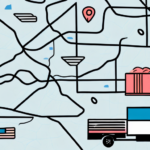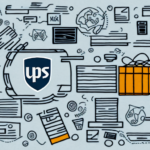Understanding Delivery Area Surcharges
If you're in the e-commerce business and rely on shipping carriers to deliver your products to customers, you've probably heard of delivery area surcharges. These fees can have a significant impact on your shipping costs and ultimately your bottom line. In this article, we'll dive into what delivery area surcharges are, how they affect shipping costs, and what you can do to avoid them or negotiate lower fees with carriers.
What are Delivery Area Surcharges?
Delivery area surcharges are fees added on top of regular shipping costs when a package is being delivered to an area deemed remote or hard to reach by the shipping carrier. These areas are often rural or located far away from the carrier's main hub, making it more costly and time-consuming to deliver packages to them.
It's important to note that delivery area surcharges can vary depending on the carrier and the specific location being shipped to. Some carriers may have different definitions of what constitutes a remote area, and therefore may apply surcharges differently. Additionally, the amount of the surcharge can also vary based on the weight and size of the package being shipped. It's always a good idea to check with your carrier to see if any delivery area surcharges will apply to your shipment.
How do Delivery Area Surcharges Affect Shipping Costs?
Delivery area surcharges can significantly increase shipping costs, especially for businesses shipping a large volume of packages to remote areas. The fees can range from a few dollars to hundreds of dollars per package, depending on the carrier and the distance of the delivery area.
According to a 2023 shipping costs report, businesses that ship frequently to remote locations can see an average increase of 15-25% in their shipping expenses due to these surcharges.
It is important for businesses to be aware of delivery area surcharges and factor them into their shipping costs. Some carriers may offer discounted rates for certain delivery areas, while others may not. It is also important to consider alternative shipping options, such as using a different carrier or consolidating packages to reduce the number of deliveries to remote areas. By being proactive and informed about delivery area surcharges, businesses can better manage their shipping costs and improve their bottom line.
Common Reasons for Implementing Delivery Area Surcharges
Carriers implement delivery area surcharges to offset the additional costs they incur when delivering packages to remote areas. Some of the factors that can contribute to higher costs include:
- Longer Travel Time: Deliveries to remote areas often require more time and resources.
- Higher Fuel Costs: Increased distance leads to higher fuel consumption.
- Specialized Vehicles: Accessing tight and winding roads may require smaller or specialized vehicles.
- Additional Security Measures: High-risk areas may necessitate extra security to protect packages.
- Compliance with Local Regulations: Obtaining permits and adhering to specific delivery requirements can add to costs.
How to Determine if Your Package is Subject to Delivery Area Surcharges
Most shipping carriers have a tool on their website that allows you to determine if your shipment is subject to delivery area surcharges. You can also contact the carrier directly to inquire about additional fees based on your shipping destination.
It is important to note that delivery area surcharges can vary depending on the carrier and the destination. Some carriers may have higher surcharges for certain areas or regions, while others may not have any surcharges at all. It is recommended to compare different carriers and their surcharge policies before selecting a shipping option.
In addition, some carriers may offer discounts or waivers for delivery area surcharges for certain customers or shipping volumes. It is worth exploring these options and negotiating with the carrier to potentially save on shipping costs.
Tips for Avoiding Delivery Area Surcharges
- Choose the Right Carrier: Select a carrier that has a lower surcharge fee for remote areas.
- Consolidate Shipments: Combine multiple packages going to the same remote area to reduce the number of surcharged deliveries.
- Optimize Packaging: Reduce the size and weight of your packages to minimize surcharge fees.
- Use Regional Carriers: Consider using regional carriers that might offer lower surcharges for specific areas.
- Leverage Technology: Use shipping software to identify and mitigate potential surcharges during the ordering process.
How to Negotiate Lower Delivery Area Surcharges with Carriers
If you frequently ship packages to remote areas, you may be able to negotiate lower delivery area surcharge fees with your carrier. Consider discussing your shipping volume and frequency to demonstrate the value of your business to the carrier, and be willing to explore alternative shipping options or carriers to find the best deal.
Another way to negotiate lower delivery area surcharges is to consider consolidating your shipments. If you have multiple packages going to the same remote area, try to combine them into one shipment. This can help reduce the overall surcharge fees and save you money in the long run.
It's also important to stay informed about carrier policies and pricing changes. Keep an eye on industry news and updates, and be prepared to negotiate with your carrier if you notice any changes that could impact your shipping costs. By staying proactive and informed, you can work to minimize delivery area surcharges and keep your shipping costs under control.
Impact of Delivery Area Surcharges on E-commerce Businesses
For e-commerce businesses, delivery area surcharges can add up quickly and significantly impact profitability. It's essential to consider these fees when budgeting for shipping costs and developing pricing strategies for products offered in remote areas.
- Negotiating with Carriers: Leveraging your shipping volume can help negotiate lower surcharges or have them waived altogether.
- Reviewing Shipping Contracts: Regularly compare rates from different carriers to ensure the best possible pricing.
- Offering Alternative Delivery Options: Provide options like in-store pickup or local delivery to reduce the number of surcharged shipments.
Understanding the Different Types of Delivery Area Surcharges
There are different types of delivery area surcharges based on several factors such as location, shipping method, and package dimensions. It's important to understand these different fees and factor them into your shipping costs to avoid any surprises when shipping packages to remote areas.
- Location-Based Surcharges: Applied when shipping to remote or hard-to-reach areas outside standard delivery zones.
- Package Dimension Surcharges: Additional fees for oversized or overweight packages due to the increased space and resources required for transport.
How to Calculate the Cost of Delivery Area Surcharges for Your Business
Most carriers provide a fee schedule for their delivery area surcharges, which you can use to estimate your shipping costs when sending packages to remote areas. Be sure to factor in the frequency of shipments and any negotiated rates when calculating the overall impact these fees will have on your business.
Additionally, consider the size and weight of your packages. Carriers may charge extra fees for oversized or overweight packages, which can significantly increase your shipping costs. To avoid these fees, consider optimizing your packaging to reduce the size and weight of your shipments.
Strategies for Managing and Budgeting for Delivery Area Surcharges
- Consolidate Shipments: Combine multiple packages destined for the same remote area into a single shipment.
- Partner with Low-Fee Carriers: Collaborate with carriers that offer lower or more flexible surcharge policies.
- Negotiate Rates: Use your shipping volume and frequency as leverage to negotiate better rates.
- Alternative Delivery Methods: Utilize local pickup or drop-off locations to minimize or eliminate surcharges.
- Adjust Delivery Schedules: Avoid peak delivery times that may incur higher surcharges.
It's also important to budget for these fees and integrate them into your pricing strategies to maintain profitability.
Stay informed about changes to delivery area surcharges and carrier fees by monitoring industry news and updates from your carriers. This proactive approach allows you to adjust your strategies accordingly and minimize the impact of these surcharges on your business.
Best Practices for Communicating Delivery Area Surcharges to Customers
When shipping packages to remote areas, be transparent with your customers about any additional fees they may incur. Clearly state the delivery area surcharge fee on your website and during the checkout process to avoid any confusion or surprises when the package arrives.
- Clear Fee Disclosure: Highlight surcharge fees prominently during the purchasing process.
- Estimated Delivery Times: Provide accurate delivery time frames for packages shipped to remote areas to manage customer expectations.
- Alternative Shipping Options: Offer lower-cost or surcharge-free shipping alternatives where possible.
By maintaining transparency, you can build trust with your customers and reduce potential dissatisfaction related to unexpected shipping fees.
Legal Considerations for Implementing and Disclosing Delivery Area Surcharges
Depending on your location, there may be legal requirements for disclosing delivery area surcharges to customers. Ensure you research and comply with any applicable regulations to avoid legal issues or negative publicity for your business.
Implementing delivery area surcharges can also impact your business's reputation and customer loyalty. Customers may feel unfairly charged for delivery, especially if they believe they are within your regular delivery area. To mitigate this, consider offering alternative options, such as free delivery for orders over a certain amount, to enhance customer satisfaction and loyalty.
Industry Trends and Future Outlook for Delivery Area Surcharges
As e-commerce continues to grow, delivery area surcharges are likely to remain an essential component of shipping costs. However, advances in technology and alternative shipping methods may provide opportunities to reduce or mitigate these fees in the future.
- Automation and AI: Improved logistics through automation can streamline delivery processes, potentially lowering costs associated with remote deliveries.
- Electric and Autonomous Vehicles: The adoption of electric and autonomous vehicles may reduce fuel costs and increase efficiency in delivering to remote areas.
- Drone Deliveries: Emerging drone delivery services could offer cost-effective alternatives for reaching hard-to-access locations.
In conclusion, understanding delivery area surcharges is critical for e-commerce businesses that rely on shipping carriers to deliver their products. By considering the factors that contribute to these fees, implementing strategies to minimize their impact, and communicating clearly with customers, your business can manage delivery area surcharges and maintain profitability in a highly competitive e-commerce landscape.






















